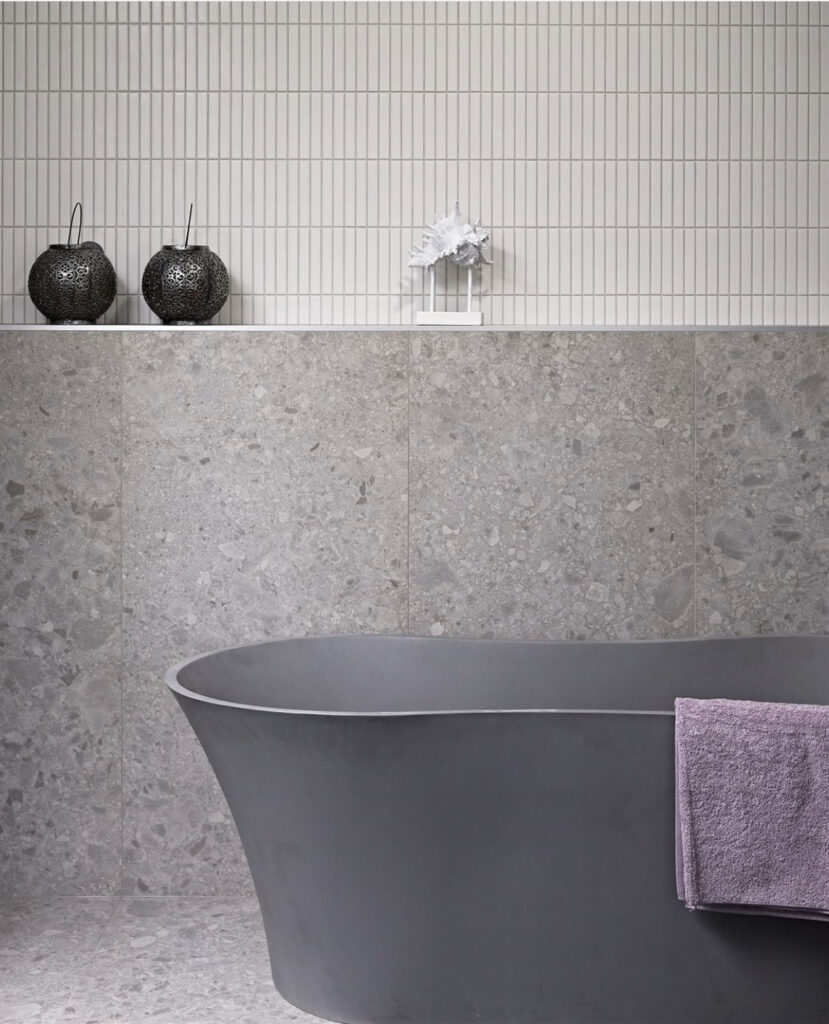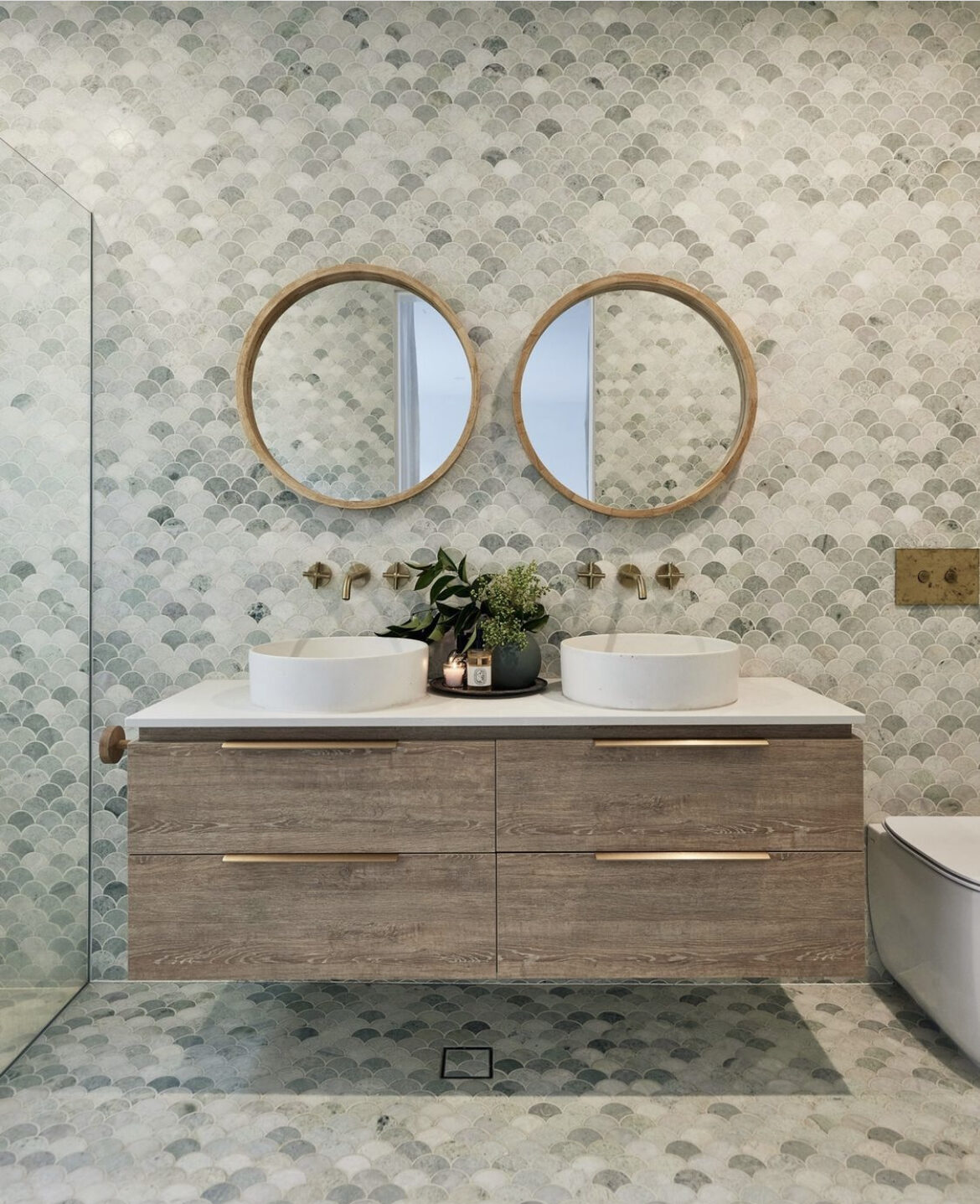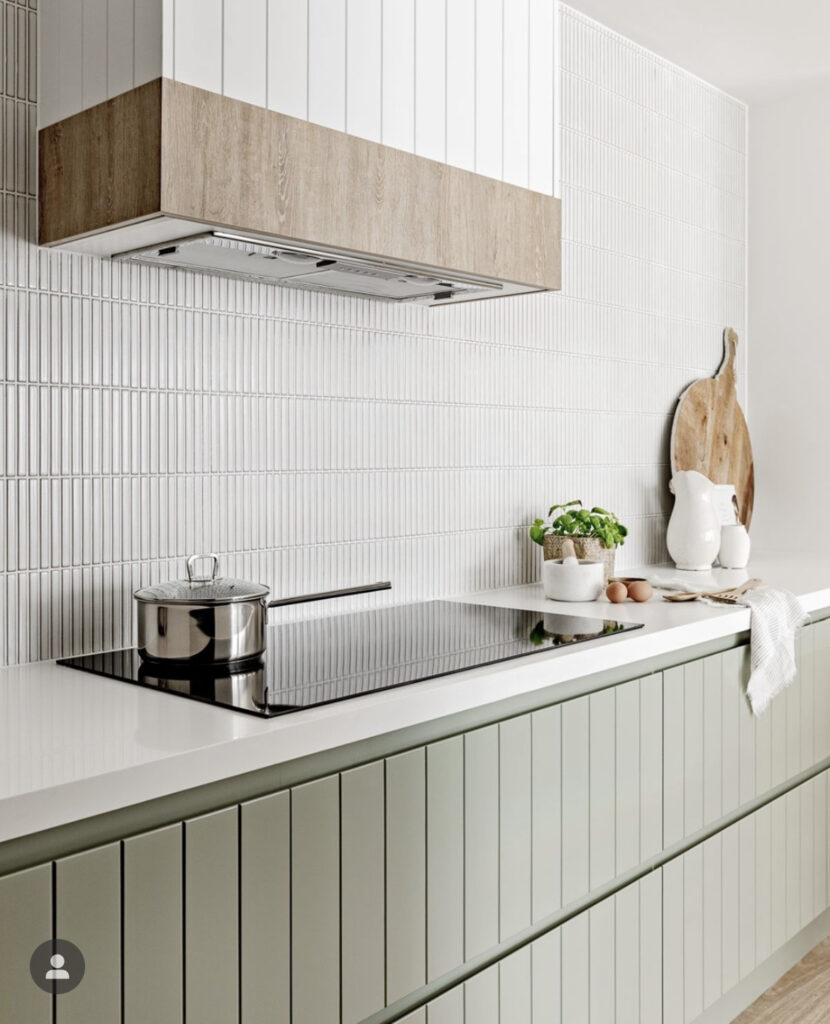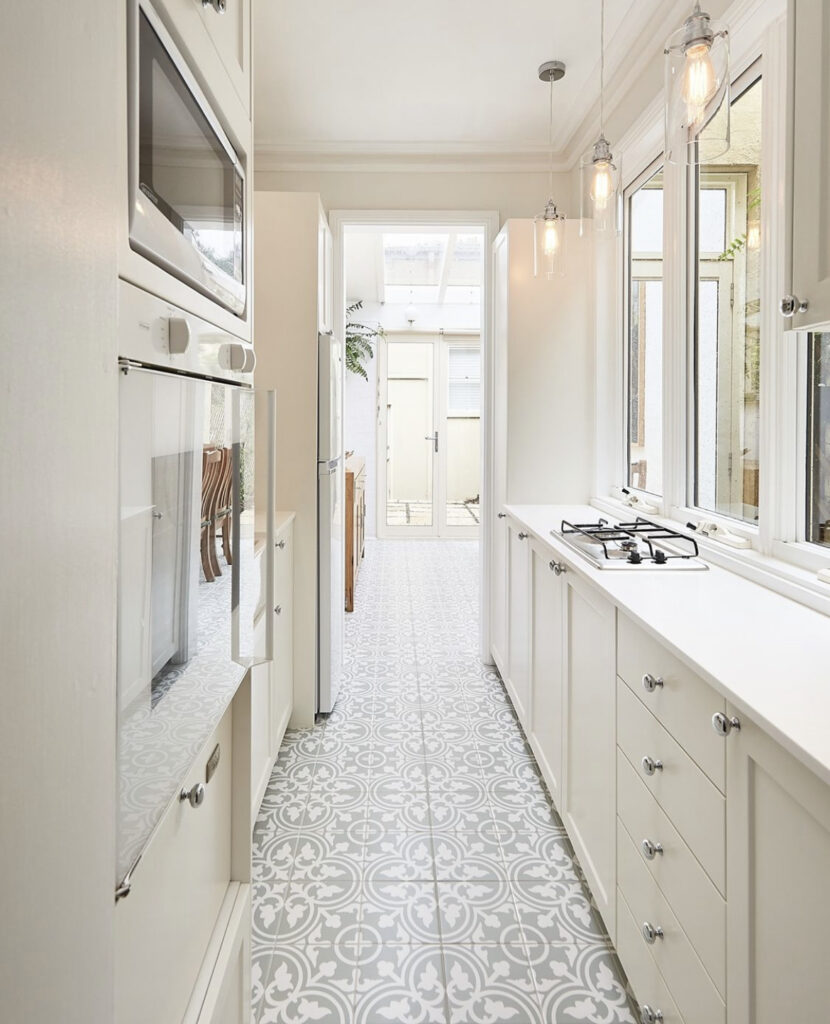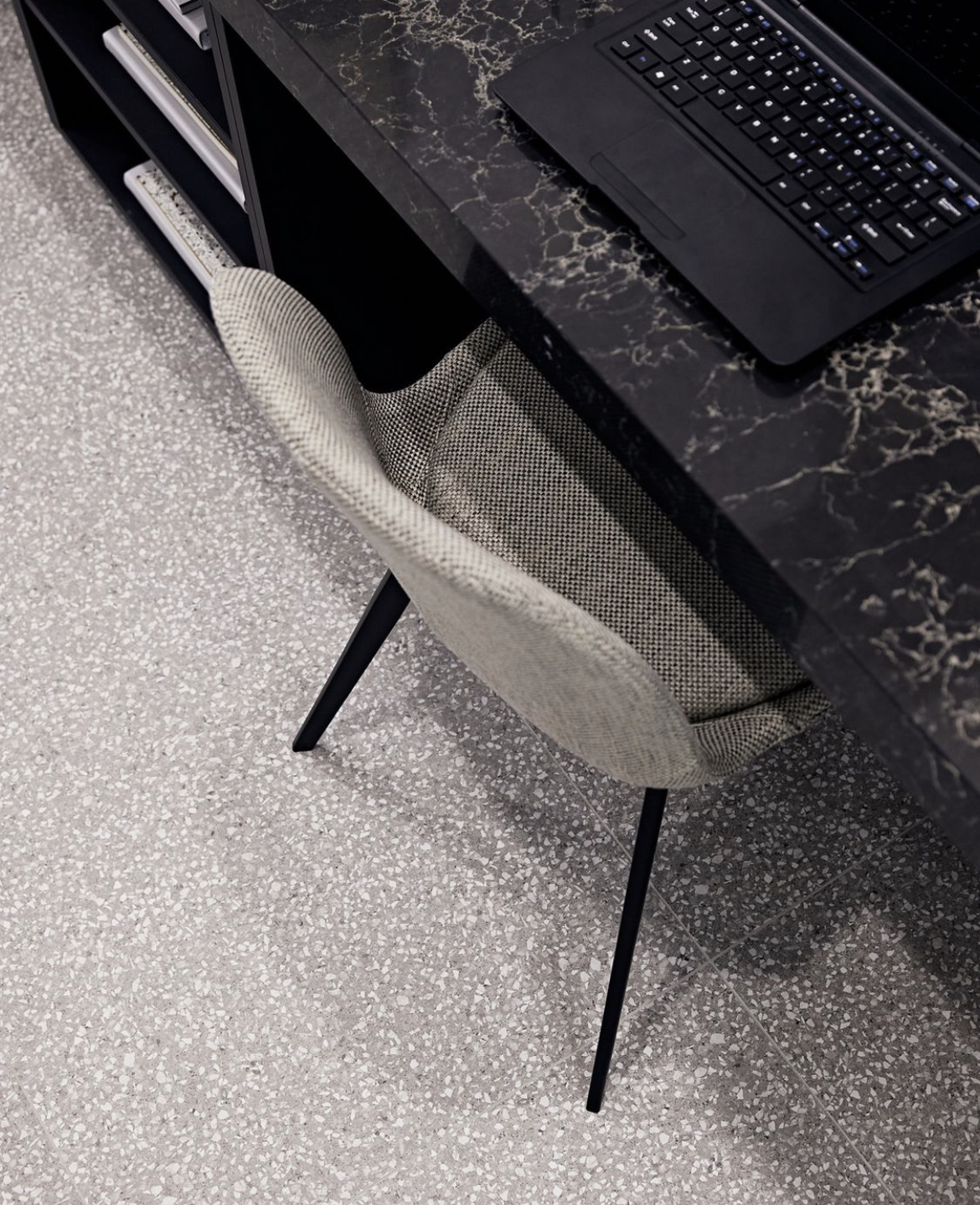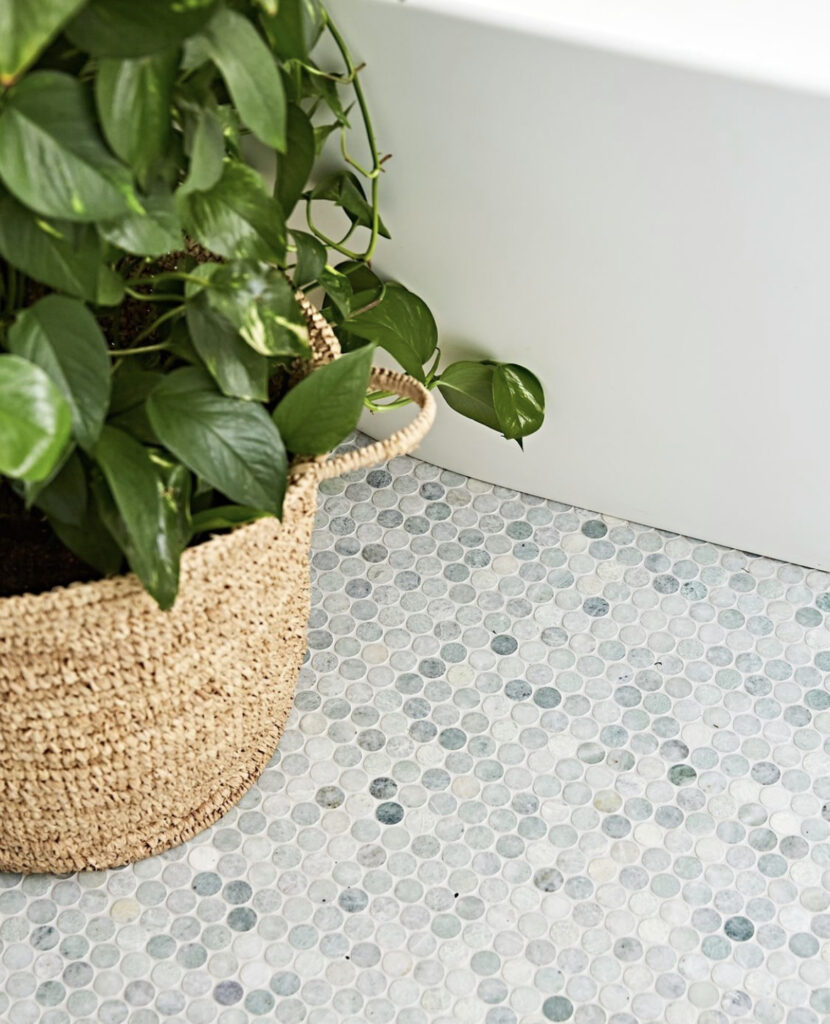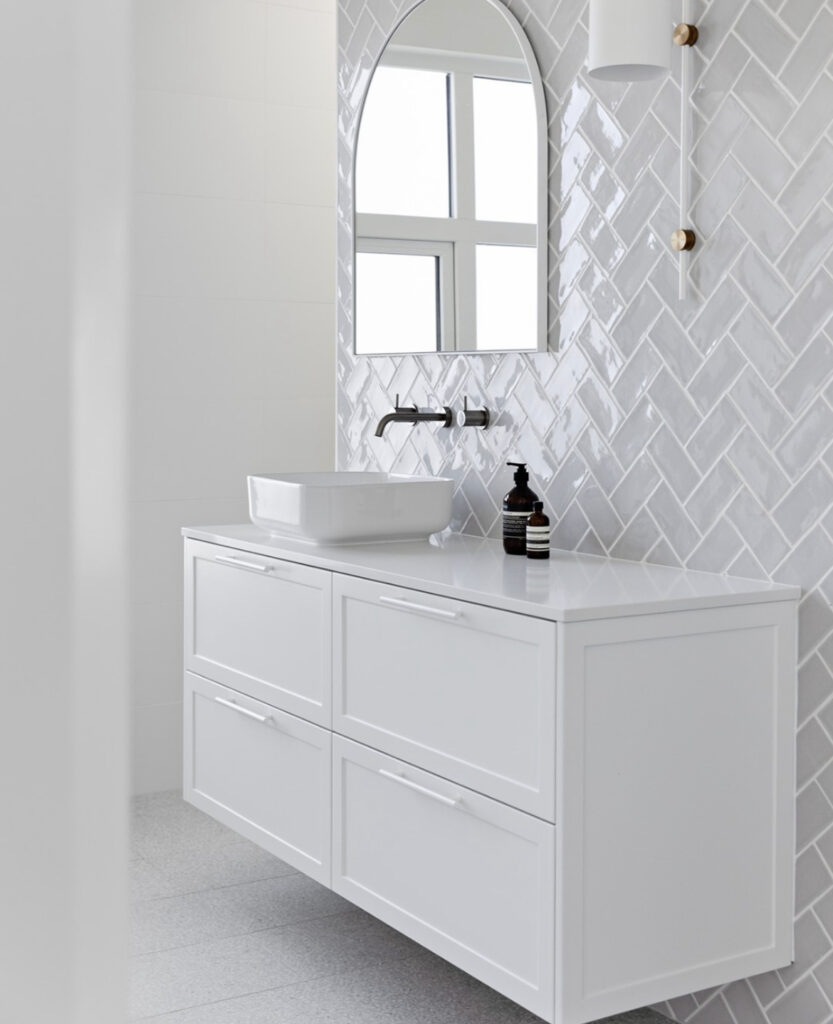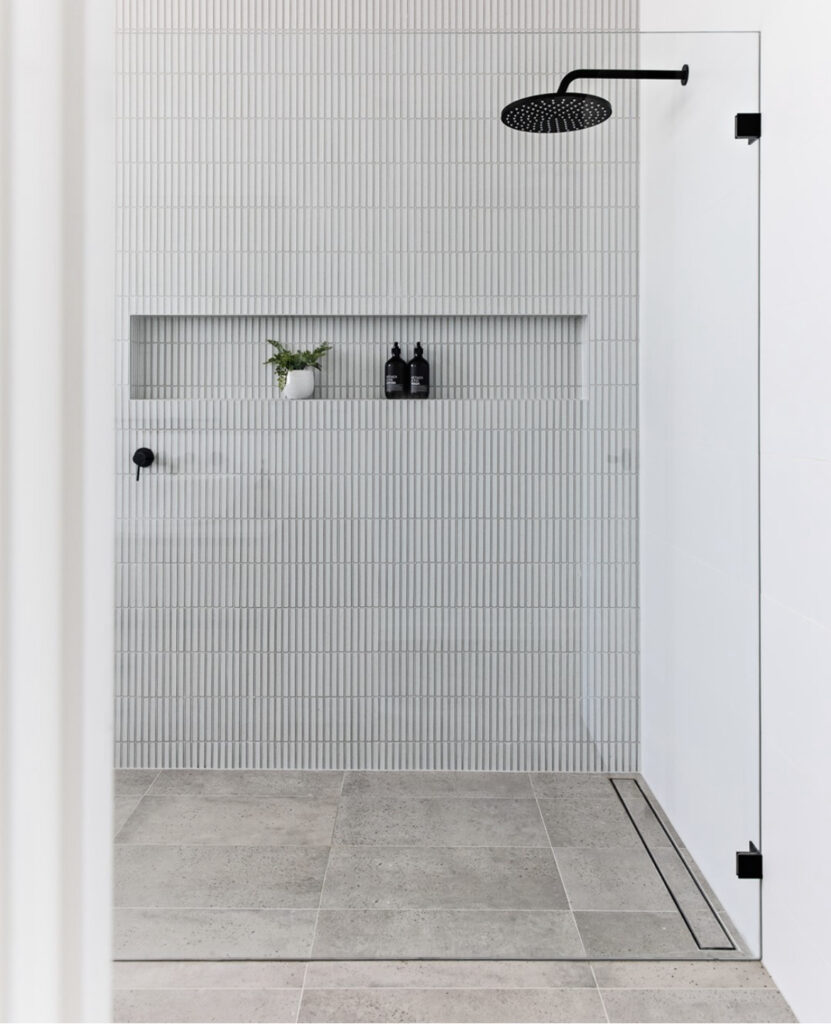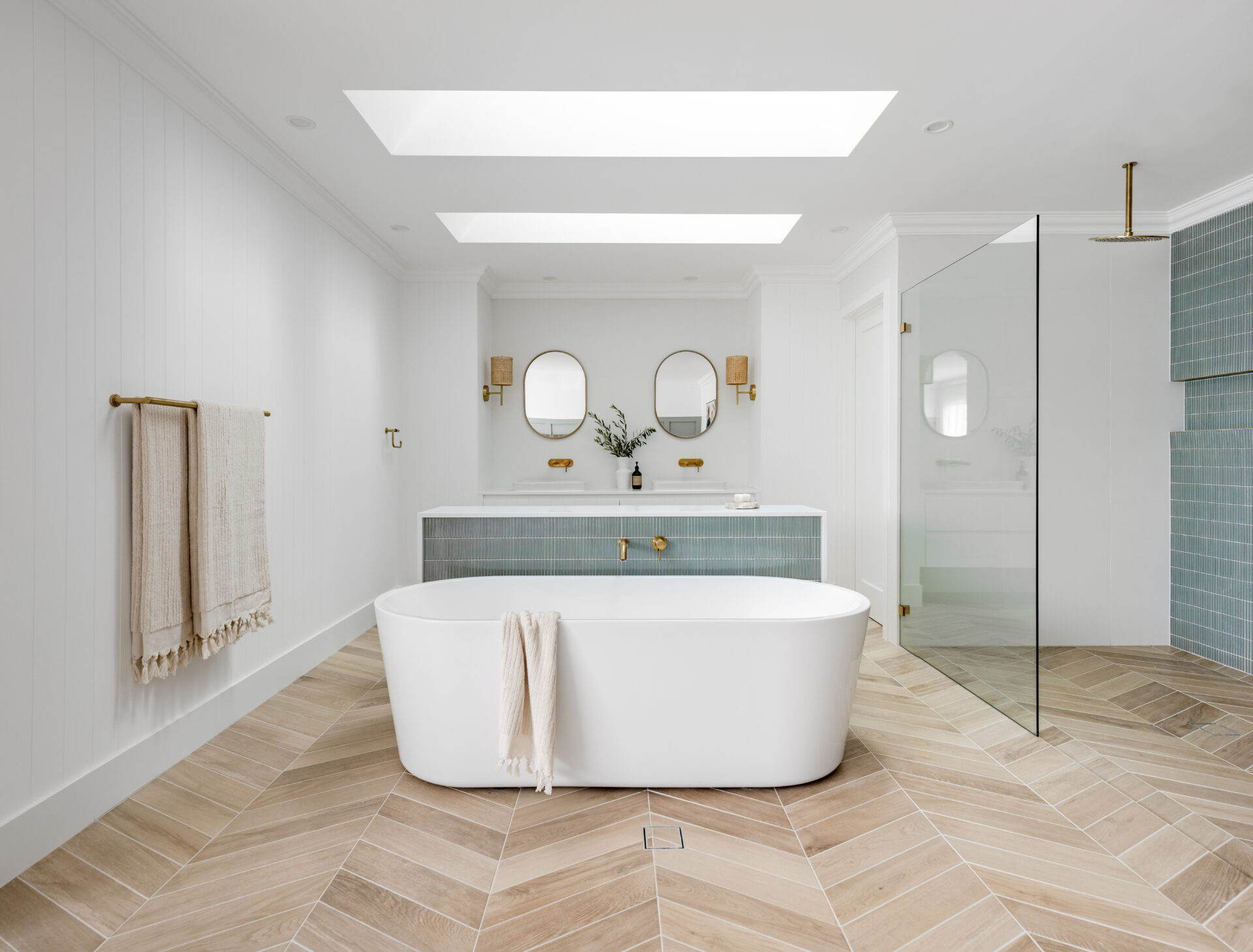
DIY Info & Advice
ColorTile Australia has been a leader in providing tile and bathroom solutions for more than 30 years. Through our experience, we have been able to construct a list of helpful pieces of advice perfect for residential and commercial tiling projects. Below you’ll find a variety of simple tile advice tips suitable for any project. Get in contact with Sydney’s leading tile supplier for more information.
Care & Maintenance
| Group | Stain type | Recommendation |
| Oil & grease | Vegetable, Mineral, Petroleum | Alkaline based detergent |
| Wax, Rubber | Scrape off, then use solvent Turpentine followed by an alkaline based detergent | |
| Lipstick, Shoe polish | Alkaline based detergent | |
| Paint (oil based), Ink | Solvent such as Turpentine or Thinner | |
| Mortar | Acidic based detergent | |
| Rust stains | Diluted hydrochloric acid or acidic based detergent | |
| Marker | Felt pen | Thinner |
| Methylene blue | Alkaline based detergent | |
| Crayon | Scrape off, then use solvent Turpentine followed by alkaline based detergent | |
| Tile grout | Cement | Diluted Hydrochloride acid |
| Latex or polymer | Solvent such as Turpentine or Thinner | |
| Epoxy | Scraper to scrape it off |
Small areas
Small public areas such as lobbies and corridors can be easily cleaned by mopping daily with warm water and an all-purpose liquid cleaner that is either neutral or mildly alkaline, i.e. pH 7-9.
Large areas
Large public areas such as shopping centers, malls and auditoriums may be cleaned with self propelled scrubbing machines using the following suggestions:
1. For daily cleaning, a detergent with a pH of 7-9 should be used.
2. For heavy cleaning, an organic acid cleaner with a pH of around 2, and containing no mineral acids, should be used. Alternatively an alkaline cleaner with a pH of up to 11 may be used, provided its sodium or potassium hydroxide content is less than 0.01% when diluted. Both should be diluted with water as recommended by the chemical manufacturer. The cleaner should be liberally applied and quickly removed from the floor by squeegee and suction as recommended by the chemical manufacturer.
3. For heavy duty scrubbing of small areas, higher alkaline cleaners up to pH 13.5 may be used provided the sodium or potassium hydroxide content is less than 2% in the concentrate and is diluted to at least 100:1 with water. The solution should then be removed from the surface with copious quantities of water. This method should not be used daily as residual cleaner will attack the tile surface and cause the grout to blacken.
Before using these products (1, 2 & 3) get professional written advice from the chemical manufacturer as to the suitability, application and frequency of use of their product on fully vitrified porcelain tiles.
1. Phosphoric acid cleaner
This is a phosphoric based acid cleaner containing detergent properties for the removal of excess grout and cement smears. It is usually used diluted with water in a ration of 1 part acid to 10 parts water for final clean up of excess grout from tiles.
NOTE: Acid cleaner must be handled with care and protective clothing and goggles must be worn. Read safety instructions before opening and applying.
2. Sodium bicarbonate
A 5-10% solution may be used to neutralise the acids used in grout removal. After reacting, the materials should be washed off with copious amount of water.
3. Cleaning detergents
These vary depending upon the application, as follows:
3.1 Post phosphoric acid cleaner
To clean up after phosphoric acid, the most suitable treatment is a neutral to slightly alkaline cleanser pH 7 to 9, designed to neutralise the phosphoric acid and maintain tiles in a clean condition.
3.2 Daily cleaning
For daily cleaning, a detergent with a pH in the range of 7-9 should be used.
3.3 Heavy cleaning
For heavy cleaning, an organic acid cleaner with no mineral acid content and a pH of 2, or an alkaline cleaner with a pH of up to 11 may be used. This is provided its sodium or potassium hydroxide content is no more than 0.01% in the liquid used.
3.4 Heavy duty scrubbing
For heavy duty scrubbing of small areas, higher alkaline cleaners up to pH 13.5 may be used provided the sodium or potassium hydroxide content is less than 2% in the concentrate, and is diluted to at least 100:1 with water. Note however that this should be removed from the surface with copious quantities of water. This should not be used in routine daily maintenance as residual cleaner will attack the tile surface and cause the grout to blacken.
Before using these products (1, 2 & 3) get professional written advice from the chemical manufacturer as to the suitability, application and frequency of use of their product on fully vitrified porcelain tiles.
4. Water
Clean water is the big secret in cleaning; it should be used to flush all detergents and acids when cleaning.
4.1 Manual cleaning
Mop and bucket. Nylon or natural bristle scrubber.
4.2 Mechanical cleaning
Large areas of plain or textured surface tiles are most readily cleaned with rotary cylindrical or reversing mechanical scrubbing machines. The scrubbing machine speed ideally should be 150 to 250 rpm. Brushes should be selected so that they effectively clean the tiles but do not damage the tile surface in any way. Scrubbing machines should be provided with a suction drying facility.
4.3 High velocity water jets
High velocity water jets are sometimes available for general use and/or for removal of stubborn dirt. These will not damage the tiles, but may erode the grout in the joints if used regularly. Check with the equipment manufacturer before using. If oil or grease is present, use the jet with warm or hot water and with neutral detergent.
- Operate in 10m2 sections to ensure greater control over the finished result.
- Sweep floor to remove all loose debris.
- Saturate the grout joints with water.
- Dilute phosphoric acid cleaner with warm to hot water, according to chemical manufacturer’s instructions and apply solution to the floor to be cleaned. Allow solution to work on the tiles for 5-6 minutes to break down excess grout, dirt and grease on the tile surface.
Do not allow the solution to dry – add more water if necessary.
- Scrub tiles with a brush or mechanical scrubbing machine (ensure the suction facility is switched off) to lift the dirt.
- Remove dirt with a wet vacuum cleaner or scrubbing machine (suction facility switched on).
- Re pass again with cleaning solution if necessary.
- Finally, before allowing the area to dry, rinse thoroughly several times, with cold clean water, agitating with the scrubbing brush or with the scrubbing machine (ensure the suction facility is switched off) to ensure complete removal before using a wet-vac to remove excess water from the surface.
NOTE: If the surface is inadequately rinsed or dried before rinsing, an off white deposit or precipitate may be left on the tile which will become more difficult to remove than the original deposit.
- Dilute cleaning detergent in warm water according to the chemical manufacturer’s instructions for high concentrations, and then apply the solution using a mechanical scrubbing machine (ensure the suction facility is switched off) or manually with a heavy scrubbing brush. The water/detergent mixture must be allowed to remain on the floor for sufficient time (5-15 minutes) to allow it to penetrate and emulsify the dirt. It is important that the cleaning detergent is completely removed by a final rinsing with clean water. Remove excess water from the surface with a wet-vac or mechanical scrubbing machine (ensure the drying facility is switched on) as it is the rinsing process that removes the dirt.
- Repeat procedure (9) weekly or as required to prevent soil build up on the tiles.
- Dilute cleaning detergent in warm water according to chemical manufacturer’s instructions for lower concentration, and apply the solution using a mechanical scrubbing machine or manually with a clean mop and bucket. It is important that the cleaning detergent is completely removed either by a final rinsing with clean water or by the squeegee vacuum action of a mechanical cleaner.
- Spillage of oil, fat or material likely to stain or cause a slipping hazard should be removed immediately by using detergent and hot water, followed by rinsing with clean water.
Whether you have purchased ceramic, porcelain, floor or wall tiles from our extensive tile range, we would like to offer you the best tile cleaning advice for your indoor and outdoor tiles.
Basic rules and recommendation
- Whatever method is chosen, remember the three golden rules of cleaning:
Rule A: Try a small inconspicuous area first.
Rule B: Rinse off well with clean water afterwards.
Rule C: Avoid using highly concentrated cleaning products for prolonged periods of time. - The sooner the cleaning is carried out, the easier the stain can be removed.
- Protect the floor if decorating, construction or overhead work is taking place.
- Locations which are permanently wet (e.g. swimming pools, showers etc.) may attract a build up of body fat, oils, soap residue, hard water deposits and in humid conditions organic growth (algae). To remove this, a more acidic cleaning agent used regularly is preferable because alkaline cleaners can react with body fats to make surfaces slippery. A plastic scouring pad is the most useful device for this type of cleaning. Before using these products, get professional written advice from the chemical manufacturer as to the suitability, application and frequency of use of their product on fully vitrified porcelain tiles.
- Powder cleaners should not be used as undissolved particles may remain and develop a haze distracting from the natural beauty of the tiles.
- Steel wool pads should not be used as they leave steel particles, which may later rust leaving brown stains.
- One source of problems with unglazed tiles comes from regular cleaning using an alkaline detergent with a pH greater than 9, which have a high concentration of sodium or potassium hydroxide. These should not be used unless the residue can be neutralised and thoroughly rinsed away with clean water, as this reaction can cause a glossy and potentially slippery surface.
- The pH of the material is the measure of acidity or alkalinity. It is a logarithmic scale with pH 7 as the neutral point. Below pH 7, the material becomes progressively more acidic, and above pH 7 more alkaline (i.e. pH 8 is 10 x more alkaline than pH 7).
- The regular use of detergents and other cleaning agents which are excessively acidic or alkaline, and contain an excess of sodium or potassium hydroxide can cause irreversible damage to the tile surface. It is important to note that acidity is less damaging than alkalinity. All products used must be recommended by the chemical manufacturer.
- Degreasing agents containing wax, sodium, silicate or other additives which leave a sticky deposit on the floor, and thus retain dirt on the surface, must also be avoided. Like any material, tiles tend to become slippery when wet. We recommend that care be taken to keep the surface dry.
- The Australian Standard for tiles which are suitable for use in wet areas of commercial amenities must meet the coefficient of friction test of at least R10.
- Please always refer to the chemical manufacturer’s instructions when using any cleaning agent. If you need more information about the use of cleaning products and the manufacturing agents in your state, please contact the Technical Services Department of the chemical manufacturer.
- Detergents build up with prolonged use and if not properly rinsed will hold in dirt, making the tiles slippery and dirty.
- Signage must be adequately displayed when cleaning tiles to warn the public or other users of the area that the tiles are wet, and care should be taken. Before using these products, get professional written advice from the chemical manufacturer as to the suitability, application and frequency of use of the product on fully vitrified porcelain tiles.
Handy Tiling Hints
Tiling is a popular home improvement task, preparation is essential in making sure your tile projects are completed without any problems. We want to highlight the most common tiling mistakes so you can avoid the grief of ruining tiles during installation for indoor and outdoor areas.
Here are 10 of the most common mistakes made during tile installation.
Unprepared Surfaces
Grouting Unevenly or Too Quickly
Dotting Corners
Choosing the wrong adhesive
Not using battens
Discovering and fixing mistakes too late
Not removing excess grout
Miscalculations with the number of tiles needed
Improper sealing of bath tops
Insufficient or erroneous planning
Below are our handy tiling hints specifically designed to provide you with simple tile tips and advice to make the most of your residential and commercial tile projects. If there is a question that we have not covered in this section please call one of our tile consultants on 1300 265 678 or visit one of our tile showrooms for more information!
Finishing Detail
Epoxy Grout
Silicone
Tiling System
Fashion
Learn About Tiles
Nano finishing is a pre-seal which eliminates the need to seal polished porcelain tiles after they are installed.
Key benefits of sealed tiles include:
- It increases water and dirt resistance
- The lifespan of a nano sealant lasts between 6-10 years.
- The sealant is anti-bacterial
- The anti-sticking technology prevents dirt from adhering to the surface and so the tile is easy to clean and stain free.
- Tile surfaces are no longer prone to mouldy growth.
- Sealed tiles are ideal for bathrooms, kitchens and any other wet area in the home. Want to know more?
Talk to your ColorTile consultant or visit a ColorTile Showroom near you
Store Enquiry
"*" indicates required fields
Absorption is the ability of the tile to take up liquids or vapours. Absorption plays a key role when it comes to outdoors, kitchen and bathroom tiles. Ceramic tiles absorb 5% or less while porcelain tiles normally absorb less than 0.5%.
Outdoor tiles are exposed to harsher conditions and therefore need to be resistant to the elements, such as rain and frost.
ColorTile has a wide selection of tiles designed specifically for indoor and outdoor use.
Floor tiles can vary by 0.75% and still be within the Australian standard. A 400mm x 400mm floor tile can vary from 397mm to 403mm. Tile sizes are only ever given as nominal measurements.
A non-vitrified tile is considered non-vitreous when water absorption exceeds 7%.
Vitrified means that the tile does not absorb water. Glaze vitrified means that the tile has been glazed.
A rectified tile is a tile that has been cut after manufacture to ensure that it is truly square. For example, a production batch of ceramic tiles which have been manufactured at 305mm x 610mm will all be re-cut to 300×600 at the same time to ensure they are all the same size and are truly square.
The reason why tilers charge more to lay a rectified tile is that typically they are laid at 1.5mm spacing (minimum allowed by Australian standards) to provide a beautiful finish. This is more difficult to lay than wider spacing as wider grout lines give more room for movement during installation. If the tiles are rectified and the grout line is 1.5mm then the tiler must ensure that the substrate is as level and perfect as possible. The thinner grout lines also mean that there is less room for error. This is time consuming work and so the installation cost reflects the extra time and care required for the job.
Economy grade tiles are generally priced in the cheapest price bracket as they are a mixture of first and second quality products which are graded by the factory at the time of manufacture. In most cases people buying economy graded tiles should expect some slight colour and size variations along with some small surface imperfections. Laid using some basic knowledge the end result will still look great.
For commercial application it is necessary that all materials comply with relevant standards (see wear resistance in the tile ratings section). Domestically, there is more scope for you, the consumer, to make up your own mind based on practical information and your own needs. However it is also wise to remember that polished porcelain or gloss glazed ceramic and porcelain tiles are more slippery than natural porcelain, or a matte glazed ceramic or porcelain tile.
Below are some of the points to consider when deciding if a polished or gloss floor tile is suitable for your project:
-
- Does anyone in your home require care? Moving around and showering can be more difficult and dangerous on a reflective floor.
- How stable are you on your feet?
- Do you wear socks or stockings when getting yourself organised in the morning?
- It is important to think about how you live and who will be living on the new floor, both now and into the future. This will help you make the right decision about the most appropriate tile finish for you.
Glaze is made up of ground glass and colour pigments which are used to create unique designs. It is a surface covering that is vitrified by firing and strongly adhered to the ceramic or porcelain body tile.
Both ceramic and porcelain are available with a high reflection. Glazed ceramics and porcelains are referred to as gloss while full-bodied or double-loaded porcelains are referred to as polished. The name for the type of reflection indicates the method by which it is achieved.
“Gloss” refers to the type of glaze used. “Polished” refers to the mechanical polishing process which occurs after the tile is manufactured.
Double-loaded porcelain is manufactured with two layers of porcelain pressed together and fired. The top layer (approx 2-5mm thick) and base porcelain are pressed together under high pressure. The top layer is made up of porcelain clays that have been randomly infused with various dyes, which create a beautiful range of colour combinations and patterns similar to natural stones.
ColorTile has a good selection of double-loaded porcelain tiles which range in colour, size, design and price.
Both ceramic and porcelain tiles are produced the same way, but the difference can be attributed to the pressing and firing process which renders the porcelain tile a superior product. Porcelain tiles are denser, harder wearing and less porous, with a very low absorption rate of under 0.05% compared to ceramic absorption rate of 5% or less.
Porcelain tiles are generally not glazed over and colour runs right through them to be polished, honed or produced in a natural finish. Ceramic tiles on the other hand are almost always finished with a durable glaze which carries the colour and pattern.
As porcelain tiles do not have this protective glaze, most of these tiles require special maintenance.
Porcelain tiles can be used in almost any internal and external application and are available in many finishes and sizes in the same series and colour formats. A high percentage of new home buyers and renovators will choose a porcelain tile due to its strength and beauty.
Ceramic tiles are low maintenance, are available in an endless colour range and are produced at a low cost. They are more suitable for use in domestic areas although chips may be noticeable due to the interior of the tile being coloured differently.
A hybrid option is to have a glazed porcelain tile which is popular for time-conscious builders and home owners. If you are a Sydney or NSW resident looking for ceramic tiles, contact ColorTile for service and advice.
Like mosaic tiles, border tiles can be manufactured from almost any material, from glass to porcelain and ceramic. ColorTile has a range of border tiles (200mm x 60mm) which can work well with many of our wall tiles.
Key benefits of border tiles include:
- Border tiles are a cost effective way of adding a feature to a tiled area such as a kitchen splashback or shower recess.
- Border tiles can be used as a capping tile when only tiling part way up a wall.
This is a man-made product composed of a blend of natural minerals and man-made agents such as polyester, glass, epoxy, and other similar ingredients.
Key benefits of engineered stone include:
- This product can give the appearance of a “stone-like” surface, but it does not possess the characteristics of a natural stone.
- It is a cheaper alternative to natural stone.
As the name would suggest, stone is a natural product. Unlike the manufacture of porcelain and ceramic tiles (which takes a raw material and processes it into a new controlled material), the production of natural stone aims to preserve as much of its natural appearance (including naturally occurring faults) as possible.
Key benefits of natural stone include:
- Natural stone has been a primary construction material since man first lived in a cave and painted on its stone walls.
- Whil natural stone must be maintained to ensure that it continues to look as beautiful in the future as the day it was installed, it is possible to have stone floors resurfaced in years to come.
- Natural stone gives any interior an element of style and refinement. The polished finish adds formality to a space while a honed finish provides a more organic look.
Mosaic tiles are very small tiles, typically less than 100mm square and are most commonly known as splashback tiles due to their popularity as a finish for kitchen and bathroom splashbacks. They are available in many different materials including porcelain, ceramic, glass, natural stone and others. They also come in various finishes.
Commonly sold pre-mounted on mesh or paper sheets around 300x300mm in size, these sheets can be cut down to generate a pattern when mixed with other tiles. For example a 300x300mm sheet of 50x50mm mosaics could but cut down into narrower strips and joined together end to end to create a feature in a shower wall.
Key benefits of mosaic tiles include:
- Mosaics are used generally as feature tiles to enhance a room.
- They can be used as splashback tiles in kitchens and bathrooms.
- They are bright and can add character without being over-powering.
- They can be a bold and dynamic statement reflecting the home owner’s personality.
- ColorTile mosaics are made from the highest quality products from around the globe.
These are composed of metal oxides and water which are spread through a screen on white porcelain. This then penetrates the body of the tile and releases the colouring during firing.
Key benefits of porcelain tiles include:
- They absorb 0.5% water or less which makes them suitable for humid areas like bathrooms, terraces or kitchens.
- Both glazed and unglazed porcelain tiles are extremely durable making them suitable for any application, from light traffic to the heaviest residential and light commercial traffic.
- Full-bodied and double-loaded porcelain tiles carry the colour and pattern into the tile, making it far more durable. It is suitable for any application ranging from residential to high-traffic commercial and industrial conditions.
This is composed of fine speckle biscuit and micronized topping. The two layers are pressed together prior to firing.
This has the same surface as the body. There are two main versions, the speckled (salt and pepper) version and the micronized grain version
Porcelain tiles are made using very fine, high quality materials with high silica content. Pressed at a high pressure rate and fired at high temperatures, they are typically much less porous than other tiles and do not always require sealing.
Porcelain tiles can either be glazed (with a gloss, matte or textured finish) or unglazed (with a natural, polished or textured finish).
To provide our customers with the best choice, ColorTile can offer all finishes for each range.Typically large format porcelain tiles are rectified which means that the tiles are cut after manufacture to ensure that that they are square. This allows for the tiles to be laid with a minimal grout line of 1.5mm as per Australian standards.
As a result of manufacturers around the world embracing continuous improvements and progressive development in technologies used for unglazed porcelain, ColorTile also offers full-bodied porcelain, double-loaded porcelain and soluble salts.
Ceramic tiles are light weight clay-based tiles. They are pressed at a lower pressure rate and fired at lower temperatures than porcelain tiles. This manufacturing process means they are always finished with a durable glaze which carries the colour and pattern. This glaze can be either gloss or matte or in some instances, there can be an additive to the glaze that gives the tile an external rating. The edge of a ceramic tile is generally not rectified which means the tiles should not be laid any closer than 3mm-5mm, depending on the quality of the substrate.
Key benefits of ceramic tiles include:
- They are used in both wall and floor applications.
- They are great for walls in any area of the home as they are cost effective whilst still giving a superior look.
- They are softer and easier to cut than porcelain which makes the installation cost more affordable.
- They usually carry a PEI ratings 1 to 5. (See tile tile ratings for more info).
- They are suitable for light to moderate traffic.
When cleaning unpolished, matte or honed tiles, it is recommended to sweep or vacuum the floor of all loose dirt, sand and other foreign materials prior to cleaning. If there are contaminants on the surface of the tile that are difficult to remove, it is important to firstly identify the specific spill or contaminant, as different surface contaminants require different cleaning methods and chemicals. The general recommendations are:
saturate the floor with a mild cleaning solution and water, and allow it to stand for 5 – 10 minutes. Do not allow the cleaning solution to dry, and add more water if necessary. It may be best to complete small areas at a time.
Remove the dirty cleaning solution, rinse the surface with clean, clear water and buff with a dry mop or towel.
For contaminants that are difficult to remove, scrub the floor with a floor machine equipped with a nylon pad or bristle brush and cleaning solution. For residential applications and small areas, a hand brush or nylon pad can be used. Remove the dirty cleaning solution and rinse the surface with clean, clear water.
Powder cleaners should not be used as undissolved particles might remain and distract from the natural beauty of unglazed or terracotta tiles.
When cleaning polished tiles it is recommended to sweep or vacuum the floor of all loose dirt, sand and other foreign materials prior to cleaning.
Mop the floor with a mild cleaning solution and water, using 50% less detergent concentrate than you would use on an unpolished floor.
Use a damp mop with clean water to remove any cleaning solution, then dry the floor thoroughly with a soft cloth or buffing pad to increase the shine and prevent water spots.
Natural Stone Products should not be cleaned with acid or acid based industrial cleaners. It is recommended that you seek professional written advice from the chemical manufacturer as to the suitability, application and frequency of use of their product on Natural Stone.
It is recommended that Natural Stone products are sealed. ColorTile recommends that you seek professional advice on pre-sealing and sealing aspects of Natural Stone.
When cleaning glazed tiles, a damp cloth is usually all it takes to bring back the gloss of the tiles. A routine clean with window cleaner may remove moderate stains and a stronger solution in necessary for heavily soiled surfaces. A mild solution of hot water and all purpose liquid cleaner or a soapless detergent is excellent for cleaning walls, floors and counter tops.
When cleaning it is important to remember:
Do not use powder based cleaners that may scratch the surface.
Do not use soap to clean, as it leaves a film which can dull the gloss of glazed tiles and also encourages the growth of bacteria and mould in damp areas.
All cleaning solution must be thoroughly removed from the tiles by rinsing with clean water.
To clean grouting, a plastic bristle brush is recommended. Steel wool pads should not be used as they leave steel particles, which may later rust leaving brown stains.
Due to the constant use of shower areas, tiles surfaces need a different cleaning procedure to remove the hard water deposits, soap scum and body oils that build up.
To avoid extra heavy cleaning, weekly cleaning is advised to maintain the level of hygiene and to remove dirt before it builds up into hard deposits. Routine build up can be removed with most all purpose cleaners, while hard water deposits can be eliminated by a solution of white vinegar and water. A plastic scouring pad is most useful for this kind of cleaning.
As shower recesses are damp by nature, bacteria and mould can develop when there is little ventilation. This can be removed by spraying or wiping with a chlorine bleach such as White King. This should be allowed to stand for 5 minutes and rinsed with clean-water. Caution should be taken when using bleach and it should never be mixed with ammonia.
Want to know more?
Store Enquiry
"*" indicates required fields
Tile Cleaning Tips
1. Phosphoric acid cleaner
This is a phosphoric based acid cleaner containing detergent properties for the removal of excess grout and cement smears. It is usually used diluted with water in a ration of 1 part acid to 10 parts water for final clean up of excess grout from tiles.
NOTE: Acid cleaner must be handled with care and protective clothing and goggles must be worn. Read safety instructions before opening and applying.
2. Sodium bicarbonate
A 5-10% solution may be used to neutralise the acids used in grout removal. After reacting, the materials should be washed off with copious amount of water.
3. Cleaning detergents
These vary depending upon the application, as follows:
3.1 Post phosphoric acid cleaner
To clean up after phosphoric acid, the most suitable treatment is a neutral to slightly alkaline cleanser pH 7 to 9, designed to neutralise the phosphoric acid and maintain tiles in a clean condition.
3.2 Daily cleaning
For daily cleaning, a detergent with a pH in the range of 7-9 should be used.
3.3 Heavy cleaning
For heavy cleaning, an organic acid cleaner with no mineral acid content and a pH of 2, or an alkaline cleaner with a pH of up to 11 may be used. This is provided its sodium or potassium hydroxide content is no more than 0.01% in the liquid used.
3.4 Heavy duty scrubbing
For heavy duty scrubbing of small areas, higher alkaline cleaners up to pH 13.5 may be used provided the sodium or potassium hydroxide content is less than 2% in the concentrate, and is diluted to at least 100:1 with water. Note however that this should be removed from the surface with copious quantities of water. This should not be used in routine daily maintenance as residual cleaner will attack the tile surface and cause the grout to blacken.
Before using these products (1, 2 & 3) get professional written advice from the chemical manufacturer as to the suitability, application and frequency of use of their product on fully vitrified porcelain tiles.
4. Water
Clean water is the big secret in cleaning; it should be used to flush all detergents and acids when cleaning.
4.1 Manual cleaning
Mop and bucket. Nylon or natural bristle scrubber.
4.2 Mechanical cleaning
Large areas of plain or textured surface tiles are most readily cleaned with rotary cylindrical or reversing mechanical scrubbing machines. The scrubbing machine speed ideally should be 150 to 250 rpm. Brushes should be selected so that they effectively clean the tiles but do not damage the tile surface in any way. Scrubbing machines should be provided with a suction drying facility.
4.3 High velocity water jets
High velocity water jets are sometimes available for general use and/or for removal of stubborn dirt. These will not damage the tiles, but may erode the grout in the joints if used regularly. Check with the equipment manufacturer before using. If oil or grease is present, use the jet with warm or hot water and with neutral detergent.
Tile Ratings
Our tile ratings provide insight to a variety of different things you should take into consideration before and after your purchase of bathroom tiles, kitchen tiles and outdoor tiles. If you wish to find out more about our tile ratings simply call us on 1300 265 678.
Shade Variation
The shade (colour, tone, texture and value) of all ceramic floor tiles vary. To help identify the expected variation, the indicators are:
V1 LOW VARIATION: Least possible shade variation among pieces of tile in a box of this product. When installed, this tile shade provides a uniform appearance and give floors and walls an even harmony.
V2 MODERATE VARIATION: Low to moderate shade variation. Like most natural materials, this tile has a subtle variation that adds a refined modulation to floors and walls.
V3 HIGH VARIATION: Considerable shade variation present among pieces of tile in a box of this product. The tiles share the same colours, but with texture variations. It provides a spontaneous shade variation within the same colour range that highlights the lustrous texture variations.
V4 RANDOM VARIATION: Highest possible shade variation. For this colours vary from tile to tile. The luxurious shade and colour shifts create customised floors which allow for rich fashion statements to emerge.
Shade variation is based on production run. Some tiles look the same when they belong to the same production run, but different when they have been produced in different runs. The changes relate to slight temperature or colouring changes.
RECOMMENDATIONS – Once delivered, check the tiles in all cartons to see if they are the same colour. Also check the code numbers of the boxes to see if they are from the same batch.
THE COLORTILE ADVANTAGE – We hold a large amount of tiles and remove batches with low stocks to minimise shade variation.
Slip Resistance
The standards for the selection of slip-resistant pedestrian surfaces in commercial projects are set by the Australian Standard HB197:1999. As a general guide:
R9 – SUITABLE FOR DRY CONDITIONS such as commercial pedestrian walkways that require high wear resistance and are easily cleaned. Venue examples include: entrance halls, corridors, shops and general pedestrian walkways.
R10 – SUITABLE FOR WET CONDITIONS such as internal / under cover commercial pedestrian walkways, which may be wet from time to time. Products with this rating have high wear resistance and a textured surface that aids water displacement and improves slip resistance.
Venue examples include: commercial toilets, ensuites, washrooms and commercial kitchens.
R11 – SUITABLE FOR HYDRO CONDITIONS such as internal and external commercial pedestrian areas that are specifically designed for wet barefoot conditions. Tiles with this rating are frost resistant, have high wear resistance and a textured surface that aids water displacement and improves slip resistance. Venue examples include: shower recesses, pool surrounds and hydrotherapy rooms.
R12 – SUITABLE FOR RAMP CONDITIONS such as wet and dry internal and external pedestrian ramps. Tiles with this rating have high wear resistance and are frost resistant.
Wear Resistance
The Porcelain Enamel Institute (PEI) has developed a rating system that assesses the wear resistance and durability for wall and floor tiles, since not all tiles can be used in all areas. The wear resistance measure equates to the PEI rating. The rating ranges from 1 to 5, classifying the tiles according to their suitability for different levels of foot traffic.
The PEI ratings and wear descriptions are:
PEI Class 1 Rating (No foot traffic) – Recommended only for wall use in residential and commercial applications.
PEI Class 2 Rating (Light traffic) – Recommended only for wall use and bathroom floor applications.
PEI Class 3 Rating (Light to moderate traffic) – Recommended for countertops, walls and floors where normal foot traffic is expected.
PEI Class 4 Rating (Moderate to heavy traffic) – Recommended for all residential applications as well as medium commercial and light institutional.
PEI Class 5 Rating (Heavy to extra heavy traffic) – Recommended for all residential as well as heavy commercial and institutional applications.
Tile Slip Resistance Standards
Understanding Australian slip resistance standards. More details
The Australian standards for slip resistance provides a guide for the slip resistance requirements of pedestrian surface materials. It highlights a selection of products based on the wet slip resistance classifications gathered from a range of new pedestrian surface materials. View the tables below for further insight.
AUSTRALIAN SLIP RESISTANT TILES STANDARDS BASED ON AS/NZS 4586
Source: CSIRO HB197 & Standards Australia AS/NZS 4586
The following tables are provided as a guide only.
General Application
Public Wet Barefoot Areas
Commercial & Industrial Applications
Tile Waterproofing
Tile waterproofing is critical in home renovations, the simple applying a waterproofing membrane can help reduce the risk of structural damage significantly.
Depending on the case, there are different methods and products available for tile waterproofing.
At ColorTile, we stock & supply a large range of waterproofing products ideal for bathrooms and other common wet areas.
Visit any of our showrooms to speak with our bathroom renovation specialists to help find the best solution for your waterproofing needs or call us directly on 1300 265 678.
![]()
